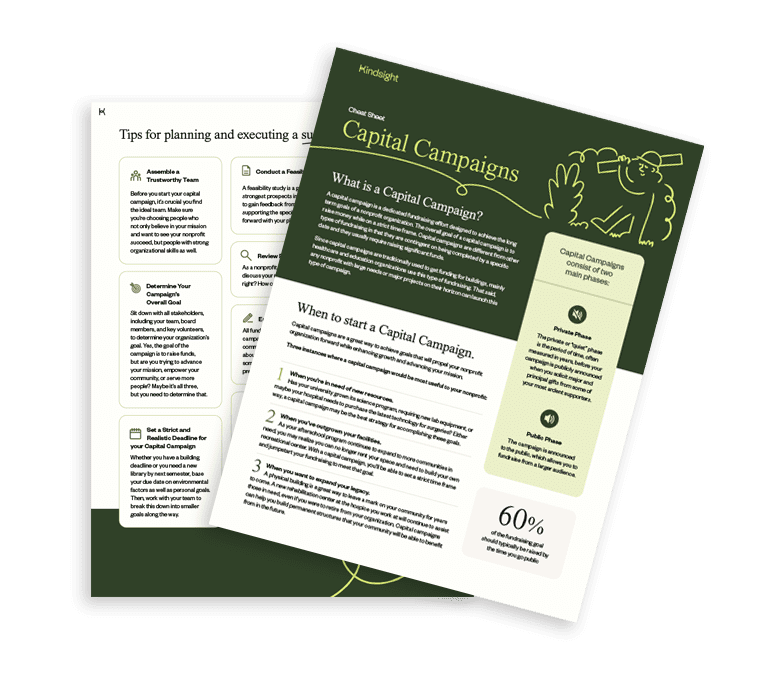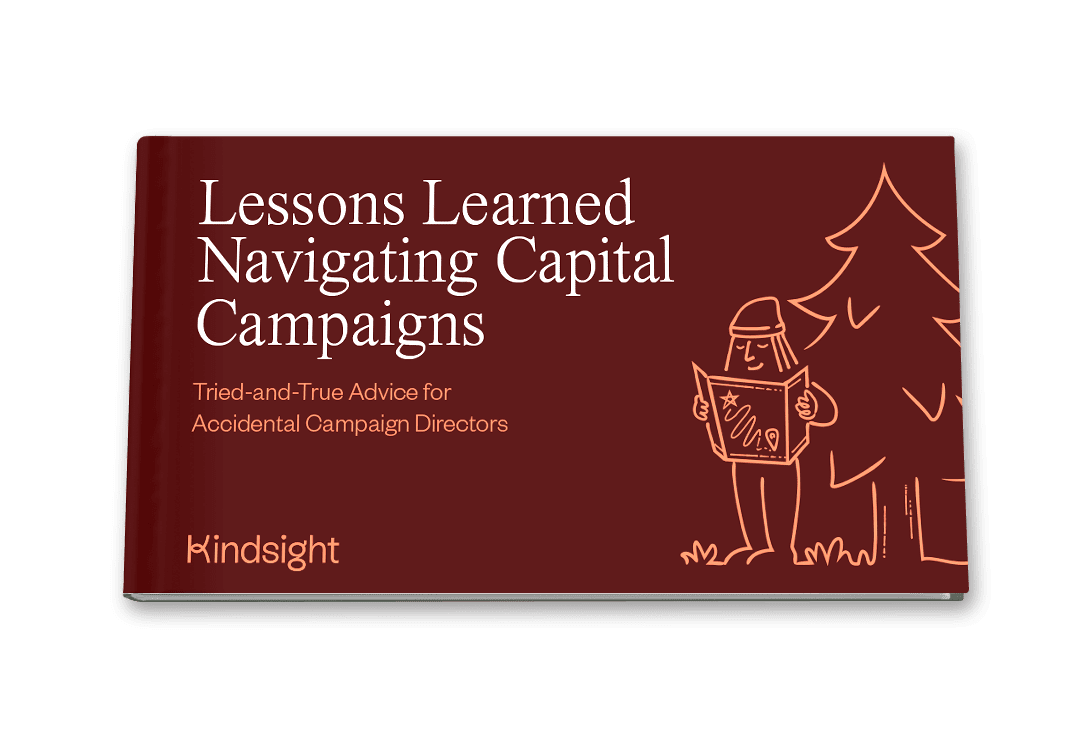
Looking to launch a capital campaign? There are a few basics you’ll need to know before you get started to guarantee you achieve all your nonprofit organization’s goals. From the basics of a capital campaign to how to build the right team, our crew at Kindsight will take you through everything you need to know to conduct successful capital campaigns.
What is a capital campaign?
A capital campaign is a fundraising strategy that’s used to achieve long-term capital goals, such as purchasing land, buying necessary equipment, erecting buildings, or adding a new wing to an existing structure. The overall goal of a capital campaign is to raise money while on a strict timeframe, which may range from months to years.
Need guidance for your next capital campaign?
Learn about when and how to start your capital campaign, what to do in each stage, and get expert tips for navigating all the crucial elements of a capital campaign.

A capital campaign is divided into three phases:
1. Planning
The planning stage involves the creation of a dedicated capital campaign team, goal setting, a feasibility study, wealth screenings, and contingency planning.
2. Implementation
The implementation phase consists of a quiet (private) phase which is when the majority of the fundraising is done. At this time, you and your team will reach out to major donors with large gift asks. This is followed by a public phase, which fills in the gaps by asking for donations from a larger public pool of donors.
3. Follow-up
The follow-up phase involves wrapping up the campaign, reflecting on the process, thanking everyone involved, and keeping your supporters updated about the progress and fruits of the capital project.
Why launch a capital campaign?
The following are common reasons to launch a capital campaign:
- Fund major one-time expenses like constructing a new building, renovating facilities, or purchasing major equipment
- Finance a major expansion of programs, services, or operations
- Build an endowment fund to provide ongoing financial stability
- Pay off existing debt from a mortgage or loans
- Support a large-scale project like opening a new location or branch
- Honor a milestone anniversary or event with a signature initiative
- Tap into donor excitement for one large collaborative effort vs. many small asks
- Unlock challenge/matching grants only available for capital projects
- Create momentum and raise an organization’s profile in the community
A capital campaign is typically used to fund a major expansion that will help your nonprofit grow over the years. Capital campaigns have earned the nickname of “brick-and-mortar campaigns” since they are traditionally used to raise money for concrete projects.
If your school needs a new science wing or your hospital wants the latest cancer imaging system, then consider funding through a capital campaign.
When should you start a capital campaign?
There are three moments in which a capital campaign would be most useful to your organization:
1. When you’re in need of new resources
Has your university grown its science program requiring new lab equipment? Does your hospital need to purchase the latest tech for surgeries? Either way, a capital campaign may be the best way to accomplish these goals!
2. When you’ve outgrown your space
As your after-school program continues to expand to more communities in need, you may realize you can no longer rent your space and need to purchase your own recreational center. With a capital campaign, you’ll be able to set a strict time frame and jumpstart your fundraising efforts to meet that goal.
3. You want to expand your legacy
A physical building is a great way to leave a mark on your community for years to come. A new rehabilitation center at the hospice you work at will continue to assist those in need even after you retire from your organization. Capital campaigns can help you build permanent structures that your community will be able to benefit from well into the future.
Who uses capital campaigns?
Nonprofits with large needs and major projects in their plans can launch this type of campaign; they are very common among healthcare and education organizations. For example, if you run an after-school program for children from underprivileged areas, a capital campaign could help you build a new recreational center so you no longer have to rent your space.
The phases of a capital campaign
There are three phases to a capital campaign, and it’s important you follow each one to ensure success in your fundraising.
1. Capital campaign planning
There’s a lot of pre-planning that needs to happen before you launch your capital campaign. This is the stage in which you’ll assemble your team and create a timeline and goals. During the planning phase, you also need to conduct a feasibility study and perform wealth screenings. Wealth screenings are designed to show you who is most likely to support your campaign based on their ability to give as well as their history of charitable giving.
1.1 Assemble a team
Before you start your capital campaign, it’s crucial you find the ideal team. Having the right people working for your cause is invaluable. Make sure you’re choosing people whose beliefs strongly align with the cause and who have the right skills to keep your project on track. In addition to paid staff members, you may also bring on volunteers eager to help throughout the capital campaign process.
Some team members you’ll need to assign:
- Capital campaign consultant: If resources allow, you may want the added support of a nonprofit fundraising consultant. To identify the best person to assist your organization, you can compare proposals from multiple firms.
- Campaign chair: Your campaign chair is one of the most important team members and will oversee all committees. This person will be the primary face of your organization’s capital campaign. They will be the point person who keeps other team members on track.
- Board members: The board members are at the forefront of big-picture decisions and are in charge of day-to-day planning and execution. These members provide approval for any spending, so choosing strong leaders is crucial.
- Planning committee: Your planning committee should consist of about 10 to 15 members who help to plan and establish a timeline for your campaign, meaning they need to have strong organizational and time management skills.
- Steering committee: After your planning committee sets up a timeline for your capital campaign, your steering committee then keeps the campaign on track. This committee can have the same members as the planning committee, but make sure to add in a few more key players as well.
- Staff: Other staff members you’ll need: major gift officers, prospect researchers, volunteer coordinators, event planners, and marketing coordinators. Choose these positions based on experience and dedication to the cause.
- Volunteers: Volunteers are the heart and soul of any nonprofit, and no fundraising endeavor would be complete without them.
Tip: Always lead by example. Make sure everyone on your board is committed to making a donation to your campaign.
Set yourself up for success: get the capital campaign cheat sheet.
1.2 Set a goal and establish a deadline
Establish practical, financial, and time goals for your capital campaign.
- Practical capital campaign goal: What are you aiming to achieve with the funds raised in the capital campaign?
- Financial capital campaign goal: How much will it cost to achieve this goal? Sit down with your builders, contractors, and anyone else who will be working on your campaign to get an accurate estimate of what your plan will cost. Then, set your end goal higher than this amount to account for unexpected costs, so you can feel confident you’ll achieve what you set out to accomplish.
- Capital campaign timeframe: Establish a capital campaign timeline with a deadline for raising the required funds. Whether you have a building deadline or you need a new library by next semester, base your due date on environmental factors as well as personal goals.
Then, work with your team to break this down into smaller goals along the way. Determine how much you need to fundraise in the initial private (quiet) phase as well as how much you hope to receive in the public portion of fundraising. As with your financial goal, consult your builders and contractors and allow additional time on top of their estimate for unforeseen delays.
1.3 Review past successes and areas of improvement
Sit down with your team to discuss your most recent fundraising efforts. What went wrong? What went right? How can you make this capital campaign even more successful?
1.4 Build a budget for the campaign
The goal of a capital campaign is to earn money for your new building or equipment. However, there are times when you may need to spend extra money to get there. Therefore, it’s important you and your team lay out a strict budget for spending.
A capital campaign will cost an organization about 10 percent of the end goal on average. For example, if your team determines it’ll cost $10 million to build a new science center at your university, expect to spend $1 million throughout the campaign.
Have your team meet and decide where you want to allocate your funds, including costs ranging from hiring consultants to direct mail materials. This will help you stay under or within your budget. In some instances, creating a budget requires you to go outside of your organization and hire a finance expert.
Make sure to also account for any unforeseen circumstances. Having extra money built into your budget ensures you won’t overspend if an issue were to arise.
Items to figure into your capital campaign budget include:
- Fundraising events: There are a variety of fundraising events you may want to host to get more donations to your cause, ranging from hosting galas for your major donors to online auctions.
- Education: Spreading the message of your cause is crucial if you want to gain more funding. You may want to hire someone to take control of your social media or a copywriter to create informational blog posts about your capital campaign.
- Marketing materials: Some marketing materials you may want to invest in include brochures, letters, pledge cards, and online advertising. You also have the option to stay in-house for advertising or to reach out to a larger agency with tons of experience.
1.5 Conduct a feasibility study
It’s vital to perform a feasibility study before you launch your capital campaign. This resource is useful for gauging whether or not you’ll be able to meet the end goal you hope to accomplish. Typically, these studies are conducted by outside consultants through various surveys and are extremely helpful in knowing whether you should launch your campaign.
Prior to the quiet portion of fundraising, the consultants will interview 20 to 40 board members within your community to see if they would be willing and able to financially support your cause. At the end of the study, the results will let you know how much your existing donor pool can realistically contribute to your cause.
If your feasibility study results are not what you were hoping for, this doesn’t necessarily mean your campaign is over before it even begins. Instead, it means you need to consider what factors need to change in order for the campaign to be feasible. For example, if the findings dictate that you need more major donor support, it might be worth going back to the drawing board to find and cultivate those relationships more.
1.6 Conduct wealth screenings
It’s crucial to reach out to the right potential donors with the right gift asks. By identifying donors with both the capacity and affinity to give and aligning asks with their interests, you can maximize giving potential and set yourself up for a successful public campaign phase.
You can go about it in one of two ways. First, you can hire a team to comb through files and personal records to find the ideal donors for your cause. You’ll want to consider not only the propensity to give but how likely they are to contribute to your specific cause as well. If someone has given to like-minded organizations in the past, they’re more likely to donate to your campaign.
Your second option is to invest in a fundraising intelligence tool that provides comprehensive and up-to-date donor and prospect data, equipping your team with the insights needed to make informed and strategic gift asks.
1.7 Establish contingency plans
All fundraising runs into bumps in the road, and your capital campaign most likely will, too. Have your board members or planning committee meet before you launch your campaign to discuss how to go about any potential setbacks. Make sure they discuss how to prevent some roadblocks from occurring altogether as well, making everyone more prepared for whatever comes your way during fundraising.
2. Implementation
The implementation stage of a capital campaign is divided into a quiet phase (or private phase) and a public phase.
2.1 Quiet phase (private phase)
The quiet phase is crucial to the success of your capital campaign. Around 70 percent of capital campaign fundraising is typically done during the quiet or private phase. Therefore, it’s crucial you’re reaching out to the right people to get the funds your mission needs.
During this time, you’ll utilize your wealth screening data to contact potential donors and ask for major gifts. It’s essential when pitching your capital campaign to individual donors to know how much to ask for, to make sure you’re not leaving money on the table. A fundraising intelligence tool provides this specific information to help you reach your fundraising goals faster and with less time spent contacting donors and pitching your campaign.
Gift range charts
Another great resource to help you stay on track throughout your campaign is to create a gift range chart. A gift range chart is your organization’s way of mapping out future gifts. It works by breaking down your fundraising goal into more manageable chunks, so you can set smaller milestones throughout the campaign.
In this chart, you’ll list out how many gifts of a certain size you’re hoping to receive. The larger the gifts you receive, the fewer donors you’ll need to reach your goal.
In your chart, you’ll want to list not only the gift amount but also the number of prospective donors you can reach out to in order to reach your gift goal. Then provide a total gift amount, so you can easily add up to the total you need to meet your fundraising goal.
Tips for the quiet phase
Make the quiet phase of your capital campaign as engaging as possible. When people feel like they are receiving something in return, they are more likely to give. Consider setting up naming rights to various aspects of your building from benches outside of the structure to the name of the building itself. Other ways to engage private donors include:
- Displaying a plaque inside the building or on the grounds to honor their contribution.
- Making a website post about them with details about their story and donation.
- Offering them an exclusive tour of the new facility once construction is complete.
Once you have determined what incentives you want to offer your major donors, provide a list for them to view on a brochure or in a letter.
2.2 Applying for grants
You have the option to apply for grants during the quiet phase of your capital campaign. A grant is a large contribution to your campaign to help propel fundraising forward and enhance your mission. Some organizations may want to see 50% progress toward your fundraising goal before approving a grant whereas others may be prepared to give you a grant at the very beginning to get the ball rolling.
Grants are a great way to help set you up for more major gift donations for the rest of your campaign since they bring awareness to your cause. Smaller donors may also be more confident supporting your campaign if they see that you are already close to achieving your goal.
Please note: Capital campaign grants differ from challenge grants in that you don’t need to complete a challenge to receive the money. However, a capital campaign may also be a challenge grant in certain instances, so it’s a good idea to consider all the options available to you.
How do you find grants for a capital campaign?
To secure a grant for your capital campaign, seek out organizations that provide grants to nonprofits like yours. Each grant has specific qualifications, so make sure you’re applying to the right ones. One of the best ways to do so is to use fundraising intelligence software that locates grant opportunities that suit your organization.
Once you have found a suitable grant, craft a proposal stating why you deserve the grant and what you plan on achieving with the grant money. The person who writes this proposal needs to be a strong writer who can embody the passion and heart of your nonprofit. If your budget allows, you may want to consider hiring a grant writer who has experience obtaining grants for organizations similar to yours.
If your budget is limited, consider utilizing generative AI made for nonprofits to assist in your efforts. These tools streamline the grant writing process, offering templates and tools that help nonprofits easily structure and organize their proposals.
2.3 Kick-off
After you end the quiet portion of fundraising, you’re ready to open up your capital campaign to the public! Make sure you have a website detailing the clear mission, goals, and progress of your organization so donors can learn why they should support you. Your social media pages should also have this information available to reach a wider audience.
For a successful capital campaign kick-off:
- Invest in prospect research tools: As we mentioned before, there are many platforms you can invest in to do the hard work for you when it comes to finding the right donors for your mission. Use it to collect and then analyze profiles that examine propensity and inclination to give.
- Set goals and a timeline: Work with your planning committee to craft a timeline and strict, immovable dates for fundraising goals to be achieved.
- Craft a campaign slogan: A slogan is a crucial way to let everyone know what your organization and capital campaign are all about. You will also need to set up a website, craft brochures, write letters, and come up with pledge cards.
2.4 Public phase
This is where you open up your capital campaign to the public. You should have already raised a large portion (often around 70% of your goal) so you have a good base to work from. This is where donors giving smaller sums are integral to your campaign, and you can now focus on executing activities to engage that audience.
This might also be a time when you can reassess and decide if you need to invest in finding more new major donors to get you across the finish line.
Make fundraising exciting by hosting events or holding auctions. The best part is everything can be done online, such as a virtual silent auction, meaning you’ll be able to reach potential donors from around the world. There are lots of ways to engage the public from near and far, such as:
- Raffles: Create prizes that will excite your prospective donors from the community. Using a random number generator is an easy way to pick a winner. Then, you can stream the finale on your website and social media platforms.
- Fun run or walk: Whether you design a course or leave it up to the participants, this gets people active. There are free tracking apps with social media components, such as Strava, that allow people to connect and motivate each other while they run.
- Classes: Ask members of your organization to create videos or hold live streams in which they teach the public a specific skill. For example, someone could cook a healthy meal and another person could teach how to play a song on the guitar.
- Concert or play: Putting together a virtual concert or performance invites donors to enjoy an event from the comfort of their living room couch. Reach out to local musicians or actors who may consider contributing their talents.
Remember to always align these public activities with your brand and the essence of your nonprofit. If these are aligned, the events and activities will resonate with your core audience even more.
Tips for the public phase
Implement the following tips for a successful public phase:
- Hold regular meetings: After you officially launch your campaign, it’s important you keep everyone on your capital campaign team updated. Host weekly or monthly meetings with your steering committee and board members to ensure everyone knows what milestones you’re working toward in addition to making sure everyone is staying on target.
- Keep supporters updated: Make sure your audience is aware of all your successes along the way. Let everyone know through your website and social media pages what stepping stones you’ve reached and how your new project will improve the community. This will help keep everyone excited about your mission.
- Maintain a consistent brand: Consistency is a major key to success. Stay on brand throughout your campaign and tie all your efforts together.
- Vary your fundraising efforts: Capital campaigns can last months and even years, so it’s important you’re spreading out your various fundraising events. Diversifying your efforts not only maintains engagement with your cause but provides consistent fundraising throughout your campaign as well.
3. Follow-up
The final step in your capital campaign journey is to close out fundraising and take time to reflect, celebrate, and enjoy the fruits of your hard labor!
3.1 Wrap-up, reflect, and thank everyone involved
Ask your team what they learned, what went right, and how they can use what they learned to create more successful fundraising in the future.
Want to go more in-depth with capital campaigns?
This ebook dives into the basics of each phase of a capital campaign and guides you through the hurdles that arise in each.

During this time, you’ll also want to take special care to acknowledge and thank your volunteers. To ensure ongoing interest and future involvement, acknowledge (and in a sense “nurture”) those who have been consistently devoted to furthering your mission.
3.2 Host a wrap-up event
After the close of your capital campaign, it’s important to thank your supporters. Host an event to wrap up your goals and publicly thank major supporters. Such an event can be held virtually!
3.3 Send thank-you letters
Send out personal letters of gratitude at the conclusion of your capital campaign. Grateful donors will continue to support your cause and any future fundraising efforts your nonprofit engages in, so this is a crucial final step.
3.4 Update your donors
Keep your donors updated after the campaign so they can see the impact of their contributions. This includes providing updates on the building project or major equipment purchase as well as the health, educational, social, or personal benefits the capital investment brings to the people who use the new asset(s).
Position your capital campaign for success
Capital campaigns form the backbone of nonprofit, education, and healthcare organizations’ activities and impact. Buildings require significant funds and capital campaigns are generally required to raise them.
Even if your nonprofit is small, don’t be discouraged! Data from the Association of Fundraising Professionals shows that organizations with annual budgets under $1 million have the same success rates with capital campaigns as their larger-budget peers.
The key to a successful capital campaign is securing major gifts during the quiet or private phase. The rest of the funds are raised during the subsequent public phase. The right fundraising intelligence platform will significantly enhance the success of your campaign by connecting you with the most suitable donors for your cause.
Be the first to read our resources.
The world is changing quickly—and our resources help you stay on top of it all. Sign up to get new insights, success stories, and more, sent right to your inbox.



